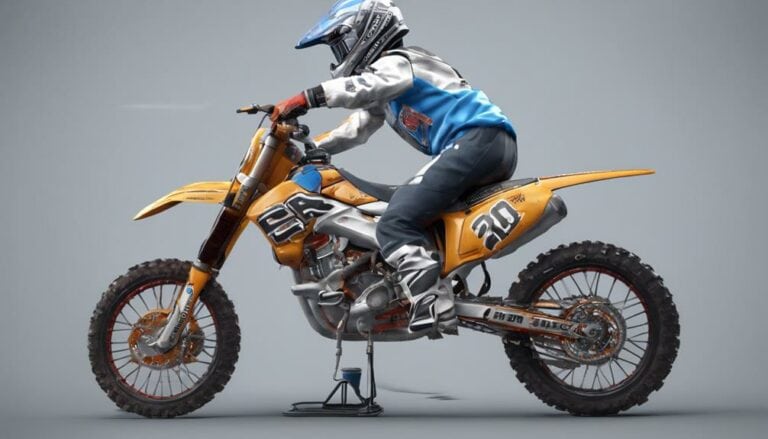To effectively troubleshoot and resolve overheating issues on your dirt bike, start by cleaning and upgrading radiators. Opt for oversized ones for intense use, install aftermarket fans, and select bike-specific coolant. Maintain the coolant level above radiator fins. Replace hoses with silicone ones, keep them straight without sharp bends, and insulate them for heat reduction. Adjust impeller position and use thermal tape for insulation. Regularly inspect components, monitor coolant levels, and check for damage or clogs. Pay attention to the water pump and thermostat. Take these steps to keep your bike cool and running smoothly.
Key Takeaways
- Regularly inspect radiator fins and coolant levels.
- Purge air pockets and use proper water-based coolant.
- Optimize hose flow with silicone hoses and straight routing.
- Adjust impeller position and insulate hoses for heat resistance.
- Monitor components, including thermostat and water pump, for wear.
Radiator Maintenance and Upgrades
To maximize the cooling efficiency of your dirt bike's radiator system, regularly clean and straighten the radiator fins. Over time, dirt, mud, and debris can accumulate in the fins, hindering proper airflow and reducing cooling performance. By carefully cleaning and straightening these fins, you guarantee that air can pass through efficiently, dissipating heat effectively.
Additionally, consider upgrading to oversized radiators for racing or high-stress conditions, as they provide increased cooling capacity.
Installing aftermarket fans and coolant recovery tanks can also help enhance your dirt bike's cooling capabilities. These additions provide supplementary cooling and aid in maintaining ideal operating temperatures, especially during intense riding sessions. Using a water-based coolant specific to your bike model, along with appropriate pressure radiator caps, is essential for efficient heat transfer and engine cooling.
Remember to maintain the coolant level about 10mm above the radiator fins to allow for expansion and ensure maximum cooling performance. Proper radiator maintenance and upgrades are vital steps in preventing overheating issues and maximizing your dirt bike's cooling system efficiency.
Coolant Selection and Air Purging
For peak performance and compatibility, choose a coolant tailored to your dirt bike model to guarantee efficient cooling and prevent overheating problems. Proper coolant selection is essential to make sure the coolant is suitable for the specific requirements of your dirt bike's cooling system.
When filling the system, it's important to purge any air pockets that may have accumulated. Air pockets can disrupt consistent coolant flow, leading to hot spots and uneven cooling throughout the engine. Utilizing a coolant funnel kit can aid in the proper filling of the system and facilitate air purging, preventing potential overheating issues.
Failure to purge air effectively can result in diminished engine performance and increased likelihood of overheating problems. By prioritizing coolant selection and air purging in your maintenance routine, you can maintain the best cooling system efficiency and prolong the life of your dirt bike's engine.
Hose Replacement and Flow Optimization
When upgrading hoses on your dirt bike, choose silicone-based replacements to withstand heat and abrasion, guaranteeing efficient coolant flow and preventing restrictions that can hinder engine cooling. Opt for straight hose routing without sharp bends to enhance coolant circulation and avoid restrictions that may impede the flow.
Consider upgrading to aftermarket water pumps to increase coolant volume and flow rate, improving overall cooling performance. Additionally, adjusting the impeller position in the water pump can optimize water flow efficiency within the cooling system, enhancing heat dissipation.
Insulating hoses with thermal tape can help reduce heat transfer and maintain proper coolant temperatures, contributing to the prevention of overheating issues. By prioritizing hose maintenance and flow optimization strategies, you can ensure effective heat management in your dirt bike's cooling system, ultimately enhancing its overall performance and durability while preventing potential overheating complications.
Impeller Adjustment and Insulation Techniques
Adjusting the impeller position in the water pump optimizes water flow efficiency, enhancing the cooling system's heat dissipation capabilities. This adjustment is essential for maintaining proper coolant volume and circulation, ultimately preventing overheating issues.
Insulating hoses with thermal tape can greatly reduce heat transfer, ensuring the coolant stays at the ideal temperature for effective heat dissipation. Using silicone-based hoses further enhances the cooling system's efficiency by resisting heat and abrasion, enabling smooth coolant flow.
Eliminating bends in hoses is vital to promote uninterrupted coolant flow, preventing the formation of hot spots that could lead to overheating.
Preventive Measures and Monitoring
Inspecting the dirt bike's cooling system components regularly is paramount to preemptively identify potential issues and maintain peak performance. Regular maintenance is essential to make certain the cooling system operates at its best.
Monitor coolant levels consistently to prevent overheating, as low levels can lead to insufficient cooling capacity. Conduct thorough radiator inspections for damage, leaks, or clogs that may hinder proper function. Check the water pump for wear or leaks that could impede coolant flow, causing overheating.
It's vital to keep a close eye on the thermostat to guarantee it allows proper coolant circulation. Be vigilant for any coolant leaks around hoses, radiators, or the water pump, as they signify potential overheating issues.
Conclusion
In summary, by following these steps for troubleshooting and resolving overheating issues on your dirt bike, you can guarantee peak performance and longevity of your cooling system.
Remember, prevention is key to avoiding costly repairs and potential damage to your engine. Stay proactive in maintaining your bike's cooling system to enjoy many more rides without the worry of overheating.
Ride on with confidence and peace of mind knowing your dirt bike is in top condition.

